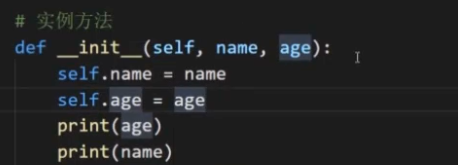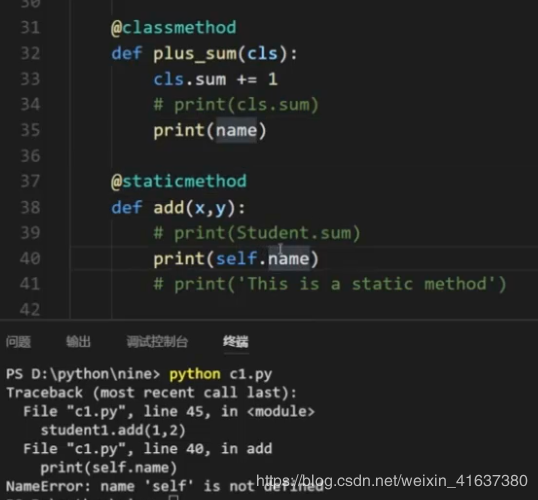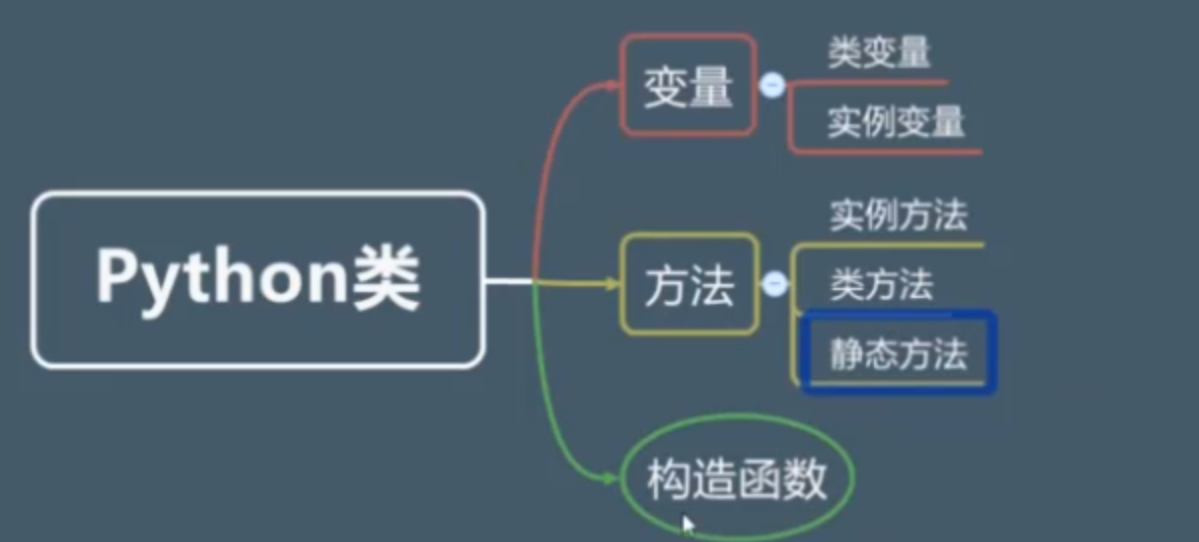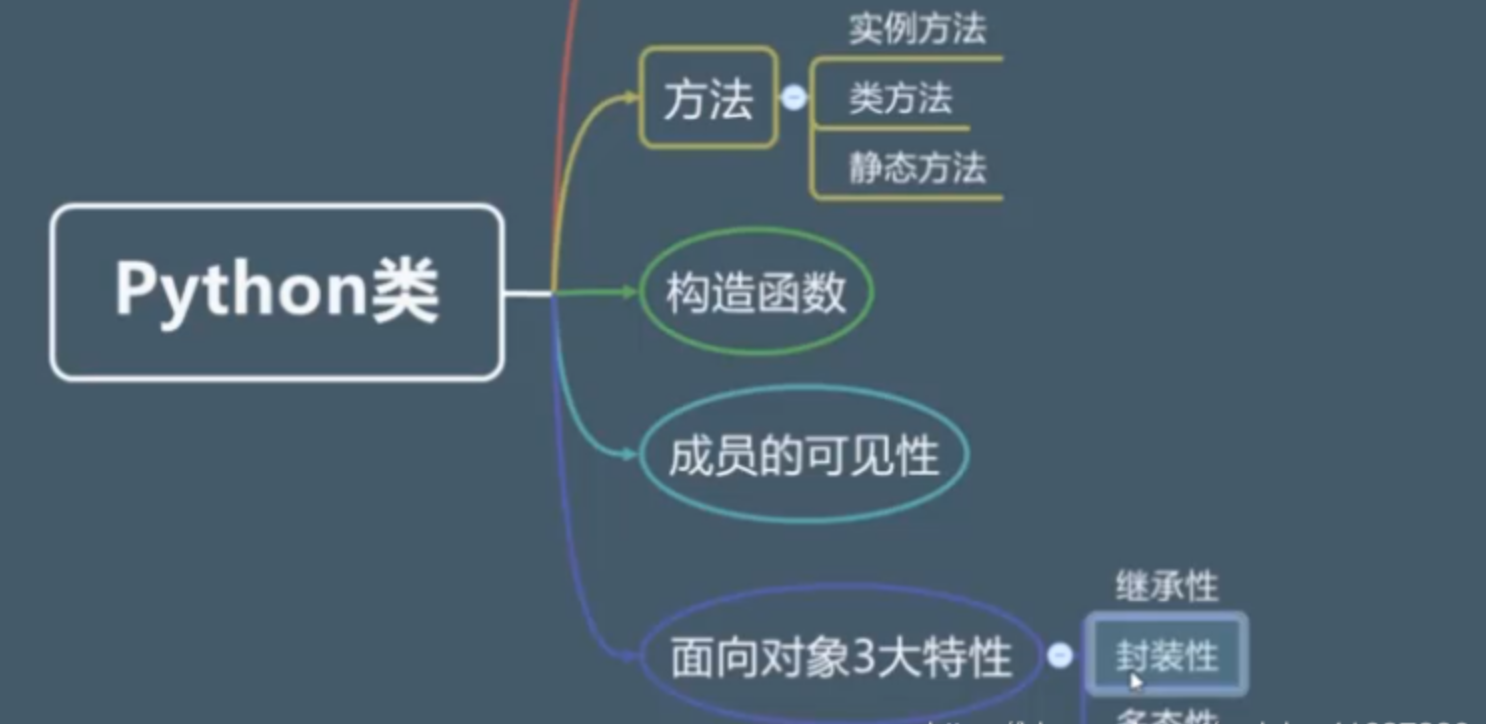Python3(六) 面向对象
一.类的定义
1.
class Student(): name = ' ' #定义变量 age = 0 def print_file(self): #定义函数 print('name:' + self.name) print('age:' + str(self.age)) class StudentHomework(): homework_name = ' ' #使用类需要对类进行实例化 student = Student() student.print_file() #调用类下面的方法
- 类的最基本作用就是在封装代码。
- 类的内部不能调用类的方法,类只负责去描述和定义,而不负责执行,运行和调用类需要放在类的外部。
- 不推荐在一个模块中既定义类又使用类。
2.在一个模块中调用另一个模块的类:
#c2.py中的代码 from c1 import Student#Student类属于c1模块 student = Student()#实例化 student.print_file()#调用Student类中的print_file()方法
二.函数与方法的区别
方法是设计层面上的称谓,更多的是面向对象中的概念;
函数是程序运行的,面向过程的一种称谓。
没有必要特别的去区分方法和函数。
变量出现在类中更多称为数据成员。
三.构造函数
1.实例化创造不同的对象。
student1 = Student() student2 = Student() student3 = Student() print(id(student1)) print(id(student2)) print(id(student3)) 结果 #3269808 #3410256 #3410320
2.
def __init__(self):声明构造函数
- 构造函数的调用是自动进行的
- 我们可以去主动调用构造函数
- 对构造函数来说只能 return None
3.构造函数的作用
class Student(): name = '' #定义变量(类变量) age = 0 def __init__(self,name,age): #初始化对象的属性 name = name age = age student1 = Student('朱可爱',18) print(student1.name,student1.age) #返回了空字符串
返回空字符串的原因:类变量和实例变量的原因,实质上返回的是类变量
尝试访问实例变量时:在实例变量列表里查找,如果没有会到类变量里面寻找。如果类中没有会到父类寻找。
模块中的类似情况:局部变量不会覆盖全局变量
c = 50 def add(x,y) c = x + y #这个c不会覆盖全局变量的c print(c) 结果: 3
50
四.类变量与实例变量
1.定义:
类变量:和类相关的变量(类变量不会受实例变量的影响)
实例变量:和对象相关联的变量
2.代码
class Student(): name = 'cute' age = 0 def __init__(self,name,age): self.name = name self.age = age student1 = Student('朱可爱',18) #实例变量 student2 = Student('朱cute',19) print(student1.name) print(student2.name) print(Student.name)#类变量不会受实例变量的影响 结果: #朱可爱 #朱cute #cute#类变量不会受实例变量的影响
五.self与实例方法
1.如果在类中定义实例方法的话,要固定在类中放上self


2.self代表实例而不是类,注意:self不能称作关键字,self可以改为任意值,但是python建议使用self
3.实例方法是实例可以调用的方法,和对象实例相关联。
六.在实例方法中访问实例变量与类变量
1.在构造函数内部访问实例变量:
class Student(): name = '123' age = 0 sum = 0 def __init__(self,name,age): self.name = name self.age = age print(self.name) #读取的是self.name,访问实例变量要加self print(name) #读取的是形参的name,如果形参列表变成(self,name1,age),则会报错 student1 = Student('cute',18) 结果: cute cute
2.在实例方法中访问类变量:
print(Student.sum1) #第一种访问类变量的方式(类名.变量名)
print(self.__class__.sum1) #第二种访问类变量的方式
class Student(): name = '123' age = 0 sum1 = 0 def __init__(self,name,age): self.name = name self.age = age print(Student.sum1) #第一种访问类变量的方式(类名.变量名) print(self.__class__.sum1) #第二种访问类变量的方式 结果: 0 0
七.类方法
类变量的使用场景:
class Student(): name = '123' age = 0 sum1 = 0 def __init__(self,name,age): self.name = name self.age = age self.__class__.sum1 += 1 print("当前班级人数为" + str(self.__class__.sum1)) student1 = Student('cute',18) student2 = Student('朱cute',18) student3 = Student('朱可爱',18) 结果: #当前班级人数为1 #当前班级人数为2 #当前班级人数为3
1.定义类方法:
@classmethod #装饰器 def 方法名(cls): #class简写,cls代表调用类方法的类。cls可以换成别的名字,但是不建议更换 pass
2.类方法里操作类变量:(更改类变量的使用场景的代码)
class Student(): name = '123' age = 0 sum1 = 0 def __init__(self,name,age): self.name = name self.age = age #self.__class__.sum1 += 1 #print("当前班级人数为" + str(self.__class__.sum1)) @classmethod def plus_sum(cls): cls.sum1 += 1 print(cls.sum1) student1 = Student('cute',18) Student.plus_sum() #调用类方法 student2 = Student('朱cute',18) Student.plus_sum() student3 = Student('朱可爱',18) Student.plus_sum()
3.区别:实例方法关联对象,类方法关联类本身。
4.可以用对象调用类方法:
student1 = Student('cute',18) student1.plus_sum() #可以,但是最好不要,在逻辑上说不通
八.静态方法
1.定义静态方法:
@staticmethod #装饰器 def 方法名(x,y): #没有指代 pass
2.静态方法能够被类和对象调用:
@staticmethod #装饰器 def add(x,y): #没有指代 print('This is a static method') student1 = Student('cute',18) student1.add(1,2) #被对象调用 Student.add(1,2) #被类调用 结果: This is a static method This is a static method
3.静态方法内部可以访问类变量
@staticmethod #装饰器 def add(x,y): #没有指代 print(Student.sum1) #可以访问类变量 print('This is a static method')
4.静态方法和类方法都无法访问实例变量。

5.能用静态方法的时候都可用类方法替代,最好不要经常使用,与类和对象的关联性非常弱,和普通的函数几乎没有区别。


九. 成员可见性:公开和私有
1.成员需要有一定的调用层级,以打分为例:
class Student(): name = '123' age = 0 sum1 = 0 score = 0 def __init__(self,name,age): self.name = name self.age = age self.score = 0 def marking(self,score): if score < 0: #可以对数据进行判断 score = 0 self.score = score print(self.name + '本次考试分数为' + str(self.score)) student1 = Student('cute',18) student1.marking(100) #利用marking方法打分
2.
不加双下划线:公开
加双下划线:私有 eg:__add
前后都有双下划线:公开,是python内置函数的命名风格。eg:__init__():
3.尝试从外部访问私有变量:
class Student(): def __init__(self,name,age): self.name = name self.age = age self.__score = 0 def marking(self,__score): if __score < 0: __score = 0 self.__score = __score print(self.name + '本次考试分数为' + str(self.__score)) student1 = Student('cute',18) student1.marking(100) student1.__score = -1 #没有报错 print(student1.__score) 结果: 100 -1
__score不是私有变量吗?为什么在外部赋值又可以访问呢?因为,student1.__score = -1 实际上是给sutdent1新添加了一个实例变量。
举例:如果没有新添加,是不能在外部访问私有变量
class Student(): def __init__(self,name,age): self.name = name self.age = age self.__score = 0 def marking(self,__score): if __score < 0: __score = 0 self.__score = __score print(self.name + '本次考试分数为' + str(self.__score)) student1 = Student('cute',18) student2 = Student('朱cute',19) student1.marking(100) student1.__score = -1 #实际上是利用python动态特性,给student1添加了一个新的属性叫__score, 并不是实例变量中的__score print(student1.__score) #结果:-1 print(student2.__score) #报错了
通过这种方式可以间接的读取私有变量:单下划线 + 类名 + 双下划线 + 实例变量名
举例:
print(student2._Student__score) #读取到了私有变量,不会报错 结果:本次考试分数为59
10.继承
#Filename:cls.py class People(): def __init__(self,name,age): self.name=name self.age=age def sayHello(self): print('Hello!')
import cls class Student(cls.People): pass stu=Student('Tom',18) stu.sayHello()
输出结果:
Student类继承了People类的方法
import cls class Student(cls.People): def __init__(self,name,age,score): self.score=score cls.People.__init__(self,name,age) def sayHello(self): print('Hi!') stu=Student('Tom',18,90) stu.sayHello()
输出结果:
子类扩展了父类的init()方法,但是调用父类的init方法时,必须要传入self
然后子类又重写了父类的sayHello()方法
调用父类的方法时也可以使用super()
import cls class Student(cls.People): def __init__(self,name,age,score): self.score=score super(Student,self).__init__(name,age) def sayHello(self): print('Hi!') stu=Student('Tom',18,90) stu.sayHello() print(stu.name) print(stu.age)
输出结果:
使用super()可以不用指定父类名称
11.多继承
python可以多继承
class A(): def __init__(self): print('a') class B(): def __init__(self): print('b') class C(A,B): pass c=C()
输出结果:
如果父类有相同的方法,子类会优先调用先被继承的类的方法
12.多态
class C(): def say(self): pass class B(C): def say(self): print('B') class A(C): def say(self): print('A') b=B() a=A() b.say() a.say()
输出结果:

